Brad and Theresa Opportunity Cost of Producing One Pound of Beef
MACRO EXAM 1
question
b. the factors of production are labor, land, and capital
answer
In the circular-flow diagram, a. firms own the factors of production. b. the factors of production are labor, land, and capital. c. the factors of production are also called \"output.\" d. All of the above are correct.
question
c. the factors of production, households are sellers and firms are buyers
answer
In the circular-flow diagram, in the markets for a. goods and services, households and firms are both sellers. b. goods and services, households are sellers and firms are buyers. c. the factors of production, households are sellers and firms are buyers. d. the factors of production, households and firms are both buyers.
question
a. households are sellers and firms are buyers
answer
In the markets for the factors of production in the circular-flow diagram, a. households are sellers and firms are buyers. b. households are buyers and firms are sellers. c. households and firms are both buyers. d. households and firms are both sellers.
question
d. 750
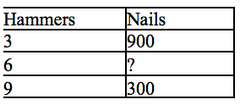
answer
The following table contains some production possibilities for an economy for a given month. Refer to Table 2-1. If the production possibilities frontier is bowed outward, then \"?\" could be a. 400. b. 450. c. 600. d. 750.
question
d. both a and b are correct
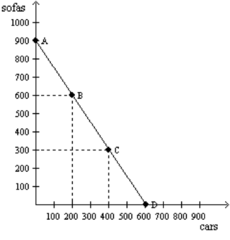
answer
Consider the production possibilities frontier for an economy that produces only sofas and cars. The opportunity cost of each car is a. the slope of the production possibilities frontier. b. 3/2 sofas. c. 2/3 of a sofa. d. Both a and b are correct.
question
a. 60 bushels of apples
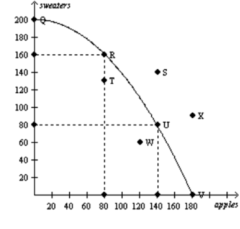
answer
Refer to Figure 2-14. The opportunity cost of moving from point U to point R is a. 60 bushels of apples. b. 80 bushels of apples. c. 80 sweaters. d. 160 sweaters.
question
c. 1000 bushels of corn and 2000 bushels of wheat
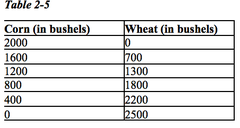
answer
Refer to Table 2-5. Table 2-5 shows one set of production possibilities. Which of the following combinations of corn and wheat is not currently attainable but would be attainable if there was an improvement in overall production technology? a. 1600 bushels of corn and 300 bushels of wheat b. 1400 bushels of corn and 800 bushels of wheat c. 1000 bushels of corn and 2000 bushels of wheat d. 600 bushels of corn and 1800 bushels of wheat
question
a. bowed outward indicating increasing opportunity cost
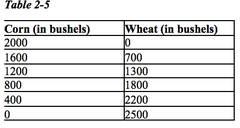
answer
Refer to Table 2-5. Table 2-5 shows one set of production possibilities. Based on the values in the table, the production possibilities frontier is a. bowed outward indicating increasing opportunity costs. b. bowed outward indicating decreasing opportunity costs. c. a straight line indicating constant opportunity costs. d. bowed inward indicating increasing opportunity costs.
question
b. resources are not completely adaptable
answer
Economists believe that production possibilities frontiers are often bowed because a. trade-offs inevitably create unemployment. b. resources are not completely adaptable. c. opportunity costs are constant. d. of improvements in technology.
question
d. all of the above are correct
answer
On a bowed production possibilities frontier, as you move down along the curve a. more of one good must be given up to receive one unit of the other good. b. the available production technology does not change. c. the opportunity cost increases. d. All of the above are correct.
question
a. increases as more of the good is produced
answer
When a production possibilities frontier is bowed outward, the opportunity cost of producing an additional unit of a good a. increases as more of the good is produced. b. decreases as more of the good is produced. c. does not change as more of the good is produced. d. may increase, decrease, or not change as more of the good is produced.
question
d. resources are specialized; that is, some are better at producing particular goods rather than other goods
answer
Production possibilities frontiers are usually bowed outward. This is because a. the more resources a society uses to produce one good, the fewer resources it has available to produce another good. b. the opportunity cost of producing a good decreases as more and more of that good is produced. c. of the effects of technological change. d. resources are specialized; that is, some are better at producing particular goods rather than other goods.
question
c. often have a bowed shape
answer
Economists believe that production possibilities frontiers a. never have a bowed shape. b. rarely have a bowed shape. c. often have a bowed shape. d. always have a bowed shape.
question
d. 4500

answer
Refer to Table 2-2. If the production possibilities frontier is bowed outward, then \"?\" could be a. 6000. b. 5500. c. 5000. d. 4500.
question
d. the opportunity cost of an additional 200 shoes increases as more socks are produced
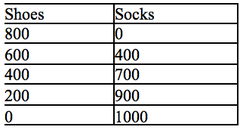
answer
Refer to Table 2-3. Which of the following statements is correct? a. The opportunity cost of an additional 200 shoes is constant at 200 socks. b. The opportunity cost of an additional 200 shoes is constant at 300 socks. c. Footville's production possibilities frontier is a straight, downward-sloping line. d. The opportunity cost of an additional 200 shoes increases as more socks are produced.
question
b. A and B
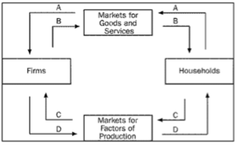
answer
Refer to Figure 2-1. Raymond buys a refrigerator for his new home. To which of the arrows does this transaction directly contribute? a. A only b. A and B c. C only d. C and D
question
d. C and D
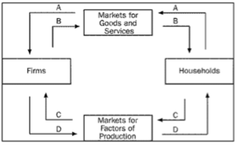
answer
Refer to Figure 2-1. Harvey receives his first paycheck for working as an ice cream vendor. To which of the arrows does this transaction directly contribute? a. B only b. A and B c. C only d. C and D
question
b. flows of inputs from households to firms
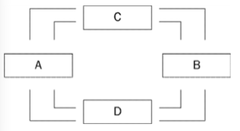
answer
Refer to Figure 2-2. If the outer loop of this circular-flow diagram represents flows of dollars, then the inner loop includes a. flows of goods and services from households to firms. b. flows of inputs from households to firms. c. flows of rent payments paid to owners of land. d. flows of wages and salaries paid to workers.
question
d. from box D to box B
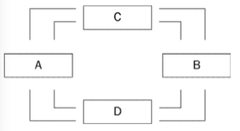
answer
Refer to Figure 2-2. Devin works as an attorney for a corporation and is paid a salary in exchange for the legal services he performs. Juan owns office buildings and rents his buildings to companies in exchange for rent payments. If Devin's income is represented by a flow of dollars from Box D to Box B of this circular-flow diagram, then Juan's income is represented by a flow of dollars a. from Box A to Box C. b. from Box C to Box A. c. from Box B to Box D. d. from Box D to Box B.
question
b. from box B to box C
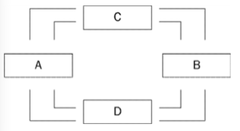
answer
Refer to Figure 2-2. Carla regularly buys fruits and vegetables at a grocery store. Roberto regularly pays a lawn-care company to mow his lawn. If the flow of fruits and vegetables from the grocery store to Carla is represented by an arrow from Box C to Box B of this circular-flow diagram, then the money paid by Roberto to the lawn-care company is represented by an arrow a. from Box A to Box D. b. from Box B to Box C. c. from Box C to Box B. d. from Box D to Box A.
question
b. goods and services sold
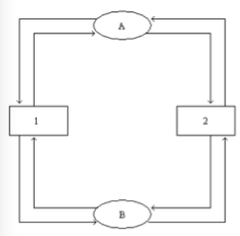
answer
Refer to Figure 2-3. What is flowing from rectangle 1 to oval A? a. revenue b. goods and services sold c. factors of production d. labor, land, and capital
answer
Scenario 1-3 It costs a company $35,000 to produce 700 graphing calculators. The company's cost will be $35,070 if it produces an additional graphing calculator. The company is currently producing 700 graphing calculators. ***What is the company's marginal cost?
question
No, because the marginal cost ($70) is less than the marginal benefit ($60)
answer
Scenario 1-3 It costs a company $35,000 to produce 700 graphing calculators. The company's cost will be $35,070 if it produces an additional graphing calculator. The company is currently producing 700 graphing calculators. ***A customer is willing to pay $60 for the 701th calculator. Should the company produce and sell it? Explain.
answer
Scenario 1-3 It costs a company $35,000 to produce 700 graphing calculators. The company's cost will be $35,070 if it produces an additional graphing calculator. The company is currently producing 700 graphing calculators. ***What is the minimum price the company will charge for the 701th calculator?
question
d. none of the above is correct
answer
The production possibilities frontier illustrates a. the trade-off between efficiency and equality. b. the combination of output that an economy should produce. c. the combination of output that each member of society should consume. d. None of the above is correct.
question
d. all of the above are correct
answer
Bridget drinks three sodas during a particular day. The marginal benefit she enjoys from drinking the third soda a. can be thought of as the total benefit Bridget enjoys by drinking three sodas minus the total benefit she would have enjoyed by drinking just two sodas. b. determines Bridget's willingness to pay for the third soda. c. is likely different from the marginal benefit provided to Bridget by the second soda. d. All of the above are correct.
answer
The property of society getting the most it can from its scarce resources is called a. efficiency. b. equality. c. externality. d. productivity.
question
a. except to the extent that you pay more for them , opportunity costs should not include the cost of things you would have purchased anyway
answer
Which of the following is correct concerning opportunity cost? a. Except to the extent that you pay more for them, opportunity costs should not include the cost of things you would have purchased anyway. b. To compute opportunity costs, you should subtract benefits from costs. c. Opportunity costs and the idea of trade-offs are not closely related. d. Rational people should compare various options without considering opportunity costs.
question
b. the values of the best opportunity a student gives up to attend college
answer
The opportunity cost of going to college is a. the total spent on food, clothing, books, transportation, tuition, lodging, and other expenses. b. the value of the best opportunity a student gives up to attend college. c. zero for students who are fortunate enough to have all of their college expenses paid by someone else. d. zero, since a college education will allow a student to earn a larger income after graduation.
question
b. $42,600 ***21,000 + 11,000 + 1,800 = 33,800 ***16,000 – 7,200 = 8,800 ***33,800 + 8,800 = 42,600
answer
Consider Frank's decision to go to college. If he goes to college, he will spend $21,000 on tuition, $11,000 on room and board, and $1,800 on books. If he does not go to college, he will earn $16,000 working in a store and spend $7,200 on room and board. Frank's cost of going to college is a. $33,800. b. $42,600. c. $49,800. d. $57,000.
question
c. the $45,000 salary that you will be able to earn after having completed your graduate program
answer
Suppose after graduating from college you get a job working at a bank earning $30,000 per year. After two years of working at the bank earning the same salary, you have an opportunity to enroll in a one-year graduate program that would require you to quit your job at the bank. Which of the following should not be included in a calculation of your opportunity cost? a. the cost of tuition and books to attend the graduate program b. the $30,000 salary that you could have earned if you retained your job at the bank c. the $45,000 salary that you will be able to earn after having completed your graduate program d. the value of insurance coverage and other employee benefits you would have received if you retained your job at the bank
answer
Consider Paul's decision to go to college. If he goes to college, he will spend $90,000 on tuition, $15,000 on room and board, and $7,000 on books. If he does not go to college, he will earn $22,000 working at a construction job and he will spend $11,000 on room and board. Paul's cost of going to college is a. $96,000. b. $110,000. c. $114,000. d. $123,000.
question
d. $18,000 instead of attending college.
answer
If Faith attends college, it will take her four years, during which time she will earn no income. She will pay $50,000 for tuition, $12,000 for room and board, and $5,000 for books. If she spends the four years working rather than attending college, she will pay $18,000 for room and board, pay no intuition, and buy no books. Based on this information, Faith's economic cost of attending college would be $67,000 if, over the four years, she could earn a. $12,000 instead of attending college. b. $14,000 instead of attending college. c. $16,000 instead of attending college. d. $18,000 instead of attending college.
question
a. can be thought of as the total benefit Ashley enjoys by eating two bananas minus the total benefit she would have enjoyed by eating just the first banana.
answer
Ashley eats two bananas during a particular day. The marginal benefit she enjoys from eating the second banana a. can be thought of as the total benefit Ashley enjoys by eating two bananas minus the total benefit she would have enjoyed by eating just the first banana. b. determines Ashley's marginal cost of the first and second bananas. c. does not depend on how many bananas Ashley has already eaten. d. cannot be determined unless we know how much she paid for the bananas.
question
d. this cannot be determined from the information given
answer
Suppose the cost of flying a 100-seat plane for an airline is $50,000 and there are 10 empty seats on a flight. The marginal cost of flying a passenger is a. $50. b. $500. c. $50,000. d. This cannot be determined from the information given.
question
d. this cannot be determined from the information given
answer
Suppose the cost of flying a 200-seat plane for an airline is $100,000 and there are 10 empty seats on a flight. The airline should sell a ticket to a standby passenger only if the passenger is willing to pay a. more than $200. b. more than $300. c. more than $500. d. This cannot be determined from the information given.
question
a. He should sell the car now for $3,800.
answer
Stephen is restoring a car and has already spent $4,000 on the restoration. He expects to be able to sell the car for $5800. Stephen discovers that he needs to do an additional $2,400 of work to make the car worth $5,800 to potential buyers. He could also sell the car now, without completing the additional work, for $3,800. What should he do? a. He should sell the car now for $3,800. b. He should keep the car since it wouldn't be rational to spend $6,400 restoring a car and then sell it for only $5,800. c. He should complete the additional work and sell the car for $5,800. d. It does not matter which action he takes since the outcome will be the same either way.
question
b. the marginal cost of the 25th house, if it is built, will equal $250,000
answer
Acme Home Builders, Inc., has built 24 houses so far this year at a total cost to the company of $4.80 million. If the company builds a 25th house, its total cost will increase to $5.05 million. Which of the following statements is correct? a. For the first 24 houses, the average cost per house was $205,000. b. The marginal cost of the 25th house, if it is built, will equal $250,000. c. If the company can sell the 25th house for at least $202,000, then it should build it. d. All of the above are correct.
question
d. cannot be determined from the information given
answer
Suppose the cost of operating a 75 room hotel for a night is $6,000 and there are 5 empty rooms for tonight. The marginal cost per room per night a. is $40. b. is $80. c. is $120. d. cannot be determined from the information given.
question
b. more than $40, as the marginal benefit will exceed the marginal cost
answer
Suppose the cost of operating a 75 room hotel for a night is $6,000 and there are 5 empty rooms for tonight. If the marginal cost of operating one room for one night is $40, the hotel manager should rent one of the empty rooms only if a customer is willing to pay a. more than $40, as the average benefit will exceed the marginal cost. b. more than $40, as the marginal benefit will exceed the marginal cost. c. more than $80, as the average benefit will exceed the marginal cost. d. more than $80, as the marginal benefit will exceed the marginal cost.
question
c. he should complete the repairs and sell the boat for $900
answer
DeShawn has spent $600 purchasing and repairing an old fishing boat, which he expects to sell for $900 once the repairs are complete. DeShawn discovers that, in addition to the $600 he has already spent, he needs to make an additional repair, which will cost another $400, in order to make the boat worth $900 to potential buyers. He can sell the boat as it is now for $400. What should he do? a. He should sell the boat as it is now for $400. b. He should keep the boat since it would not be rational to spend $1,000 on repairs and then sell the boat for $900. c. He should complete the repairs and sell the boat for $900. d. It does not matter which action he takes; the outcome is the same either way.
question
c. Betty should be willing to sell the remaining bread for any price above $0 per loaf since she will have to throw it away if she does not sell it for something.
answer
Betty's Bakery bakes fresh bread every morning. Any bread not sold by the end of the day is thrown away. A loaf of bread costs Betty $2.00 to produce, and she prices loaves of bread at $3.50 per loaf. Suppose near the end of one day Betty still has 12 loaves of bread on hand. Which of the following is correct? a. Betty should only sell the remaining bread for $3.50 per loaf since that is the regular price. b. Betty should only sell the remaining bread for $2.00 per loaf or more since that is what the bread costs to make. c. Betty should be willing to sell the remaining bread for any price above $0 per loaf since she will have to throw it away if she does not sell it for something. d. Betty should just throw the bread away and change the price of her bread starting tomorrow to make sure she sells all of her bread each day.
question
c. forgo the repairs and sell the house as it is for $250,000.
answer
Yvette buys and sells real estate. Two weeks ago, she paid $300,000 for a house on Pine Street, intending to spend $50,000 on repairs and then sell the house for $400,000. Last week, the city government announced a plan to build a new landfill on Pine Street just down the street from the house Yvette purchased. As a result of the city's announced plan, Yvette is weighing two alternatives: She can go ahead with the $50,000 in repairs and then sell the house for $290,000, or she can forgo the repairs and sell the house as it is for $250,000. She should a. keep the house and live in it. b. go ahead with the $50,000 in repairs and sell the house for $290,000. c. forgo the repairs and sell the house as it is for $250,000. d. move the house from Pine Street to a more desirable location, regardless of the cost of doing so.
question
b. how the decisions of households and firms led to desirable market outcomes
answer
The \"invisible hand\" refers to a. how central planners made economic decisions. b. how the decisions of households and firms lead to desirable market outcomes. c. the control that large firms have over the economy. d. government regulations without which the economy would be less efficient.
question
d. all of the above are correct
answer
Which of the following is an example of an externality? a. A paper mill dumps waste into the river. b. A neighbor's loud music disrupts sleep. c. A drunk driver causes an accident that injures another person. d. All of the above are correct.
question
b. cable tv provider in Tulsa
answer
An example of a firm with market power is a a. delicatessen in New York. b. cable TV provider in Tulsa. c. clothing store in Chicago. d. family farm in Kansas.
question
d. 9 percent per year
answer
In the short run, which of the following rates of growth in the money supply is likely to lead to the lowest level of unemployment in the economy? a. 3 percent per year b. 5 percent per year c. 7 percent per year d. 9 percent per year
question
b. worried about unemployment
answer
Suppose the Federal Reserve announces that it will be making a change to a key interest rate to decrease the money supply. This is likely because the Federal Reserve is a. worried about inflation. b. worried about unemployment. c. hoping to increase the demand for goods and services. d. worried that the economy is growing too slowly.
question
d. inputs into the production process
answer
Factors of production are a. the mathematical calculations firms make in determining their optimal production levels. b. social and political conditions that affect production. c. the physical relationships between economic inputs and outputs. d. inputs into the production process.
question
a. a reduction in unemployment
answer
Suppose an economy produces two goods, food and machines. This economy always operates on its production possibilities frontier. Last year, it produced 1000 units of food and 47 machines. This year, it is producing 1050 units of food and 52 machines. Which of the following events could not explain the increase in output? a. a reduction in unemployment b. an increase in available labor c. an improvement in technology d. Any of these events could explain the increase in output.
question
d. The technological advance reduced the amount of resources needed to produce 47 machines, so these resources could be used to produce more food.
answer
Suppose an economy produces two goods, food and machines. This economy always operates on its production possibilities frontier. Last year, it produced 1000 units of food and 47 machines. This year it experienced a technological advance in its machine-making industry. As a result, this year the society wants to produce 1050 units of food and 47 machines. Which of the following statements is correct? a. Because the technological advance occurred in the machine-making industry, it will not be possible to increase food production without reducing machine production below 47. b. Because the technological advance occurred in the machine-making industry, increases in output can only occur in the machine industry. c. In order to increase food production in these circumstances without reducing machine production, the economy must reduce inefficiencies. d. The technological advance reduced the amount of resources needed to produce 47 machines, so these resources could be used to produce more food.
question
a. the flow of dollars between sellers of jewelry and clothing and buyers of jewelry and clothing
answer
A certain production possibilities frontier shows production possibilities for two goods, jewelry and clothing. Which of the following concepts cannot be illustrated by this model? a. the flow of dollars between sellers of jewelry and clothing and buyers of jewelry and clothing b. the tradeoff between production of jewelry and production of clothing c. the opportunity cost of clothing in terms of jewelry d. the effect of economic growth on production possibilities involving jewelry and clothing
question
c. it does not have the resources and technology to produce that level of output.
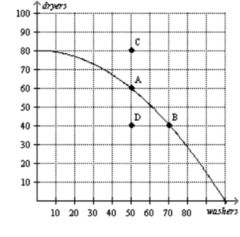
answer
Refer to Figure 2-5. This economy cannot currently produce 70 washers and 70 dryers because a. it is not using all of its resources. b. it is not using the most efficient production process. c. it does not have the resources and technology to produce that level of output. d. All of the above are correct.
question
c. there is widespread unemployment in the economy
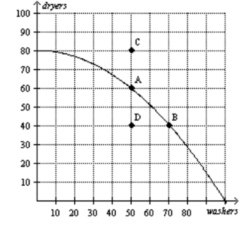
answer
Refer to Figure 2-5. Suppose this economy is producing at point D. Which of the following statements would best explain this situation? a. The economy has insufficient resources to produce at a more desirable point. b. The economy's available technology prevents it from producing at a more desirable point. c. There is widespread unemployment in the economy. d. Any of the above statements would be a legitimate explanation for this situation.
question
d. D
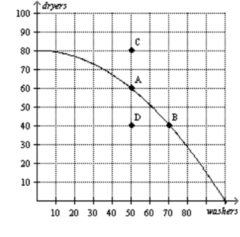
answer
Refer to Figure 2-5. Inefficient production is represented by which point(s)? a. A, B b. C c. C, D d. D
question
a. 20 dryers
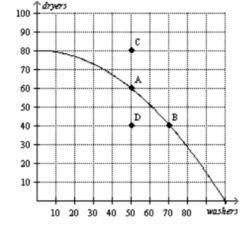
answer
Refer to Figure 2-5. The opportunity cost of this economy moving from point A to point B is a. 20 dryers. b. 20 washers. c. 20 dryers and 20 washers. d. 60 dryers.
question
a. unemployment
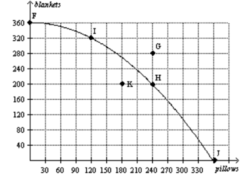
answer
Refer to Figure 2-6. A movement from point H to point K could be caused by a. unemployment. b. a decrease in society's preference for pillows. c. fewer resources available for production of pillows. d. All of the above are correct.
question
b. the economy has experienced economic growth
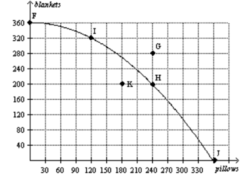
answer
Refer to Figure 2-6. If this economy moves from point F to point G, then which of the following statements is correct? a. This economy has moved from a point of inefficient production to a point of efficient production. b. This economy has experienced economic growth. c. This economy has experienced an increase in employment. d. None of the above is correct.
question
c. 120 pillows
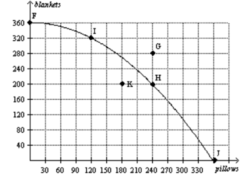
answer
Refer to Figure 2-6. The opportunity cost of this economy moving from point I to point F is a. zero. b. 40 blankets. c. 120 pillows. d. 360 blankets.
question
a. zero
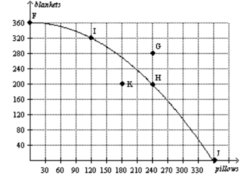
answer
Refer to Figure 2-6. The opportunity cost of this economy moving from point K to point H is a. zero. b. 50 blankets. c. 60 pillows. d. 50 blankets and 60 pillows.
question
d. 20 engines
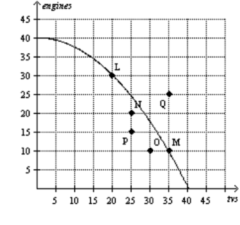
answer
Refer to Figure 2-7. What is the opportunity cost of moving from point L to point M? a. zero b. 15 tvs c. 20 engines and 15 tvs d. 20 engines
question
b. 15 tvs
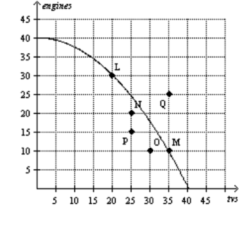
answer
Refer to Figure 2-7. What is the opportunity cost of moving from point M to point L? a. zero b. 15 tvs c. 20 engines and 15 tvs d. 20 engines
question
a. acquire more resources or experience a technological advance.
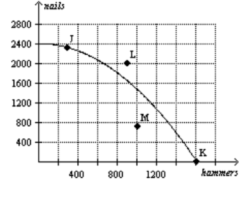
answer
Refer to Figure 2-8. To reach point L, the economy would have to a. acquire more resources or experience a technological advance. b. begin using its available resources more efficiently than it is currently using them. c. shift resources away from the production of nails and toward the production of hammers. d. None of the above are correct; the economy will never be able to reach point L.
question
b. increases
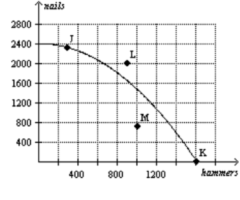
answer
Refer to Figure 2-8. For this economy, as more and more hammers are produced, the opportunity cost of an additional hammer produced, in terms of nails, a. remains constant. b. increases. c. decreases. d. This answer cannot be determined from the graph.
question
d. 6 cups of coffee
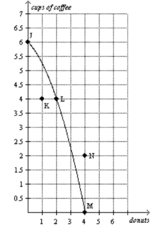
answer
Refer to Figure 2-9, Panel (a). The opportunity cost of one cup of coffee is highest when the economy produces a. 0 cups of coffee. b. 2 cups of coffee. c. 4 cups of coffee. d. 6 cups of coffee.
question
d. an improvement in both donut and coffee production technology
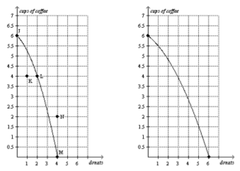
answer
Refer to Figure 2-9, Panel (a) and Panel (b). A shift of the economy's production possibilities frontier from Panel (a) to Panel (b) could be caused by a. unemployment. b. an improvement in donut production technology c. an improvement in coffee production technology d. an improvement in both donut and coffee production technology
question
d. production of 1 donut and 4 cups of coffee becomes efficient
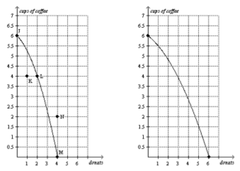
answer
Refer to Figure 2-9, Panel (a) and Panel (b). Which of the following is not a result of the shift of the economy's production possibilities frontier from Panel (a) to Panel (b)? a. the tradeoff between the production of donuts and coffee changes b. the opportunity cost of a cup of coffee is higher at all levels of coffee production c. production of 4 donuts and 2 cups of coffee becomes possible d. production of 1 donut and 4 cups of coffee becomes efficient
question
d. 24 sofas
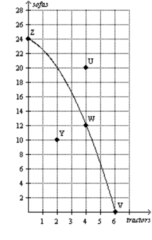
answer
Refer to Figure 2-10, Panel (a). The opportunity cost of one sofa is highest when the economy produces a. 0 sofas. b. 12 sofas. c. 20 sofas. d. 24 sofas.
question
b. Production of 2 tractors and 10 sofas becomes efficient.
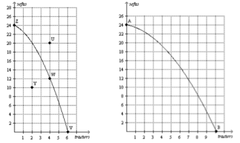
answer
Refer to Figure 2-10, Panel (a) and Panel (b). Which of the following is not a result of the shift of the economy's production possibilities frontier from Panel (a) to Panel (b)? a. The tradeoff between the production of tractors and sofas changes. b. Production of 2 tractors and 10 sofas becomes efficient. c. Production of 6 tractors and 14 sofas becomes possible. d. The opportunity cost of a sofa is higher at all levels of sofa production
question
b. The economy experienced a technological advance in the production of books.
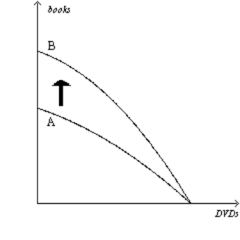
answer
Refer to Figure 2-11. Which of the following events would explain the shift of the production possibilities frontier from A to B? a. The economy's citizens developed an enhanced taste for books. b. The economy experienced a technological advance in the production of books. c. More capital became available in the economy. d. More labor became available in the economy.
question
c. economic growth
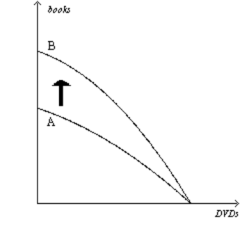
answer
Refer to Figure 2-11. The shift of the production possibilities frontier from A to B illustrates a. simultaneous technological advances in the book and DVD industries. b. a reallocation of resources away from the production of DVDs and toward the production of books. c. economic growth. d. All of the above are correct.
question
c. a general technological advance
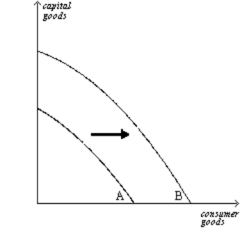
answer
Refer to Figure 2-12. Which of the following would most likely have caused the production possibilities frontier to shift outward from A to B? a. a decrease in unemployment b. a technological advance in the consumer goods industries c. a general technological advance d. an increase in the availability of capital-producing resources
question
a. analyze data on workers
answer
A duty of economists at the Department of Labor is to a. analyze data on workers. b. schedule federal holidays. c. enforce the nation's antitrust laws. d. All of the above are correct.
question
d. provide advice on tax policy to the president
answer
Economists at the Department of the Treasury a. design U.S. currency and coins. b. provide Congress with the annual budget. c. enforce the U.S. antitrust laws. d. provide advice on tax policy to the President.
question
a. advising the president and writing the annual economic report of the president
answer
Duties of the Council of Economic Advisers include a. advising the president and writing the annual Economic Report of the President. b. implementing the president's tax policies. c. tracking the behavior of the nation's money supply. d. All of the above are correct.
question
a. office of management and budget
answer
Economists at which of the following offices help formulate spending plans and regulatory policies? a. Office of Management and Budget b. Department of the Treasury c. Congressional Budget Office d. The Federal Reserve
question
c. department of the treasury
answer
The design of tax policy is one of the responsibilities of economists who work at the a. Council of Economic Advisers. b. Federal Reserve. c. Department of the Treasury. d. Congressional Budget Office.
question
d. downward slopping, and we say the variables are negatively related
answer
When two variables move in opposite directions, the curve relating them is a. upward sloping, and we say the variables are positively related. b. upward sloping, and we say the variables are negatively related. c. downward sloping, and we say the variables are positively related. d. downward sloping, and we say the variables are negatively related.
answer
The slope of a line that passes through the points (20, 30) and (40, 14) is a. -5/4. b. -4/5. c. 4/5. d. 5/4.
answer
The slope of a line that passes through the points (5, 8) and (12, 12) is a. -7/4. b. -4/7. c. 4/7. d. 7/4.
answer
The slope of a line passing through the points (15, 3) and (10, 6) is a. -3/5. b. 3/5. c. -5/3. d. 5/3.
question
a. a shift in demand
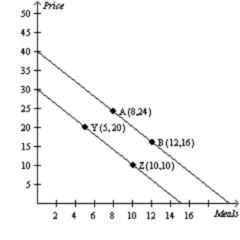
answer
Refer to Figure 2-18. A movement from point A to point Z is called a. a shift in demand. b. a movement along the demand curve. c. a shift in supply. d. a movement along the supply curve.
question
b. a movement along the demand curve
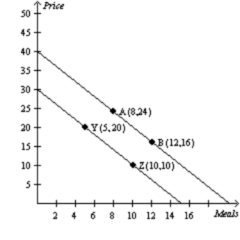
answer
Refer to Figure 2-18. A movement from point A to point B is called a. a shift in demand. b. a movement along the demand curve. c. a shift in supply. d. a movement along the supply curve.
question
c. omitted variables
answer
Suppose that someone makes the argument that because empty alcohol containers are found at many accidents, the containers cause accidents. This would be an example of a. sound logic. b. reverse causality. c. omitted variables. d. bias.
question
a. The reasoning of both Alfonso and Mary suffers from the omitted variable problem.
answer
Alfonso has noticed that increases in unemployment insurance claims are associated with recessions, and therefore he advocates limits on unemployment insurance so as to prevent recessions. Mary has noticed that most drug addicts once attended schools, and therefore she advocates getting rid of schools so as to prevent drug addiction. a. The reasoning of both Alfonso and Mary suffers from the omitted variable problem. b. The reasoning of both Alfonso and Mary suffers from the reverse causality problem. c. Alfonso's reasoning suffers from the reverse causality problem, and Mary's reasoning suffers from the omitted variable problem. d. Mary's reasoning suffers from the reverse causality problem, and Alfonso's reasoning suffers from the omitted variable problem.
question
d. No other factors besides the frequency of service affect the number of passengers
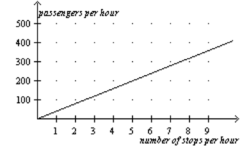
answer
Refer to Figure 2-19. Which of the following conclusions should not be drawn from observing this graph? a. There is a positive correlation between the frequency of service and the number of passengers b. When there are 5 stops per hour, there are approximately 200 passengers c. More stops per hour is associated with more passengers per hour. d. No other factors besides the frequency of service affect the number of passengers
question
b. The service frequency was increased in response to an increase in the number of passengers per hour.
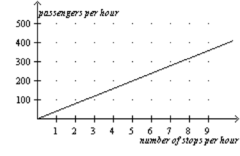
answer
Refer to Figure 2-19. A policymaker observes this graph and concludes that increasing the frequency of commuter rail service is a certain way to get more commuters to choose the commuter rail instead of driving their own cars. You warn the policymaker about making a reverse causality mistake with which of the following statements? a. Higher gas prices are causing more people to choose the commuter rail over driving. b. The service frequency was increased in response to an increase in the number of passengers per hour. c. There is a positive relationship between frequency of stops and number of passengers d. None of the above is correct.
question
d. Two countries could gain from trading two goods under all of the above conditions.
answer
When can two countries gain from trading two goods? a. when the first country can only produce the first good and the second country can only produce the second good b. when the first country can produce both goods, but can only produce the second good at great cost, and the second country can produce both goods, but can only produce the first good at great cost c. when the first country is better at producing both goods and the second country is worse at producing both goods d. Two countries could gain from trading two goods under all of the above conditions.
question
c. when the economy is self-sufficient
answer
2. An economy's production possibilities frontier is also its consumption possibilities frontier a. under all circumstances. b. under no circumstances. c. when the economy is self-sufficient. d. when the rate of tradeoff between the two goods being produced is constant.
question
c. the rate of tradeoff between the two goods being produced is constant.
answer
A production possibilities frontier is a straight line when a. the more resources the economy uses to produce one good, the fewer resources it has available to produce the other good. b. an economy is interdependent and engaged in trade instead of self-sufficient. c. the rate of tradeoff between the two goods being produced is constant. d. the rate of tradeoff between the two goods being produced depends on how much of each good is being produced.
question
d. they choose not to trade with one another
answer
Suppose there are only two people in the world. Each person's production possibilities frontier also represents his or her consumption possibilities when a. neither person faces trade-offs. b. the frontiers are straight lines. c. the frontiers are bowed out. d. they choose not to trade with one another.
question
b. the slope of England's production possibilities frontier would be -4/10 and the slope of Holland's production possibilities frontier would be -3/4.
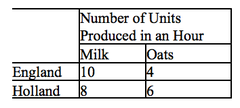
answer
assume tha t England and Holland can switch between producing milk and oats at a constant rate. 6. Refer to Table 3-2. We could use the information in the table to draw a production possibilities frontier for England and a second production possibilities frontier for Holland. If we were to do this, measuring milk along the horizontal axis, then a. the slope of England's production possibilities frontier would be -10/4 and the slope of Holland's production possibilities frontier would be -4/3. b. the slope of England's production possibilities frontier would be -4/10 and the slope of Holland's production possibilities frontier would be -3/4. c. the slope of England's production possibilities frontier would be 10/4 and the slope of Holland's production possibilities frontier would be 4/3. d. the slope of England's production possibilities frontier would be 4/10 and the slope of Holland's production possibilities frontier would be 3/4.
question
b. 24 units of cheese and 15 units of wine

answer
Refer to Table 3-3. Assume that England and France each has 40 labor hours available. If each country divides its time equally between the production of cheese and wine, then total production is a. 8 units of cheese and 10 units of wine b. 24 units of cheese and 15 units of wine c. 40 units of cheese and 20 units of wine d. 48 units of cheese and 30 units of wine
question
b. the slope of England's production possibilities frontier would be -0.25 and the slope of France's production possibilities frontier would be -2.5.

answer
Refer to Table 3-3. We could use the information in the table to draw a production possibilities frontier for England and a second production possibilities frontier for France. If we were to do this, measuring cheese along the horizontal axis, then a. the slope of England's production possibilities frontier would be -4 and the slope of France's production possibilities frontier would be -0.4. b. the slope of England's production possibilities frontier would be -0.25 and the slope of France's production possibilities frontier would be -2.5. c. the slope of England's production possibilities frontier would be 0.25 and the slope of France's production possibilities frontier would be 2.5. d. the slope of England's production possibilities frontier would be 4 and the slope of France's production possibilities frontier would be 0.4.
question
c. 3 hours ***24hr/8peanut = 3 hours
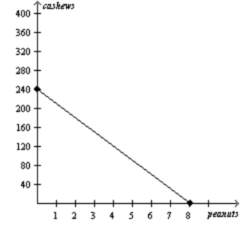
answer
Refer to Figure 3-2. If the production possibilities frontier shown is for 24 hours of production, then how long does it take Brazil to make one peanut? a. 1/10 hour b. 1/3 hour c. 3 hours d. 10 hours
question
a. 1/10 hour ***24hr/240peanuts = 1/10 hr
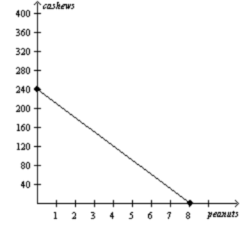
answer
Refer to Figure 3-2. If the production possibilities frontier shown is for 24 hours of production, then how long does it take Brazil to make one cashew? a. 1/10 hour b. 1/3 hour c. 3 hours d. 10 hours
question
a. 5/6 pound of beef *** 10/12= 5/6

answer
Refer to Table 3-20. What is Brad's opportunity cost of producing one bushel of wheat? a. 5/6 pound of beef b. 6/5 pounds of beef c. 3/5 pounds of beef d. 5/3 pounds of beef
question
c. 3/5 pound of beef ***6/10 = 3/5

answer
Refer to Table 3-20. What is Theresa's opportunity cost of producing one bushel of wheat? a. 5/6 pound of beef b. 6/5 pound of beef c. 3/5 pound of beef d. 5/3 pounds of beef
question
d. 4/3 tacos and Dina's opportunity cost of one burrito is 2 tacos. ***400/300 = 4/3 ***400/200 = 2
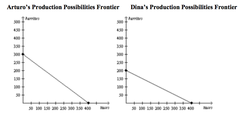
answer
Refer to Figure 3-14. Arturo's opportunity cost of one burrito is a. 3/4 taco and Dina's opportunity cost of one burrito is 1/2 taco. b. 3/4 taco and Dina's opportunity cost of one burrito is 2 tacos. c. 4/3 tacos and Dina's opportunity cost of one burrito is 1/2 taco. d. 4/3 tacos and Dina's opportunity cost of one burrito is 2 tacos.
question
b. 48 ***400/300 = 4/3 X 36/1 = 144/3 = 48
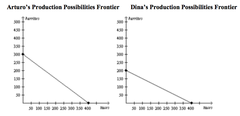
answer
Refer to Figure 3-14. Arturo would incur an opportunity cost of 36 burritos if he increased his production of tacos by a. 27. b. 48. c. 108. d. 144.
Source: https://studyhippo.com/macro-exam-1/
0 Response to "Brad and Theresa Opportunity Cost of Producing One Pound of Beef"
Post a Comment